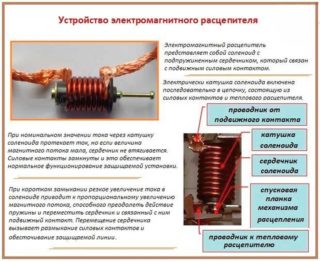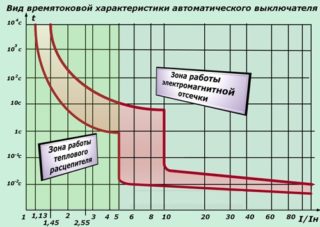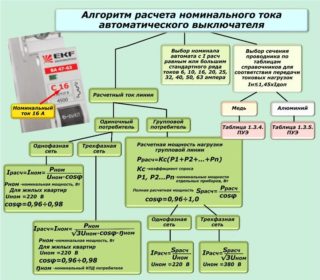To turn off, conduct and disconnect currents in the circuit, a special device is used - an automatic fuse. The device operates under conditions of a given time or abnormal phenomena of the electrical circuit - short circuits, voltage surges.
- Features and functions
- Machine device
- Release types
- Principle of operation
- Normal operation
- Terms of Use
- Classification of devices
- MA
- Class A
- Class B
- Class C
- Class D
- Classes K and Z
- Characteristics of automatic fuses
- Rated breaking capacity
- Number of poles
- Time-current indicator
- Working current rating
- Features of electronic fuses and current limiters
- How many circuit breakers can be used
- How many wires are allowed to be connected to one machine
Features and functions
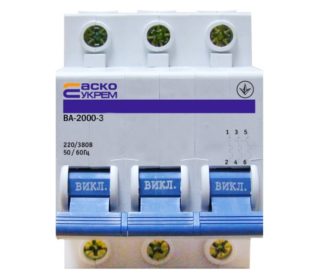
The switch is a switching device that protects the cable line from critical currents. It performs the following functions:
- prevention of damage to the conductor cores when a phase or ground is closed;
- switching of circuit sections - turns on and off individual zones;
- overload protection when powerful equipment is connected to a common network;
- switching off the mains supply in the event of short-circuit currents with limit values.
The switching devices are manually operated using an electromagnetic drive or an electric motor.
Machine device
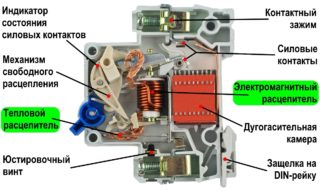
The electrical automatic fuse is available in one, two, three and four pole versions. The product includes the following units:
- contact system - three-stage, two-stage, one-stage;
- arc-extinguishing system - consists of chambers with narrow openings, with arcing grids or combined chambers;
- release drive;
- auxiliary contacts.
Also, the automatic fuses have trip units - relays with direct action.
Release types
- Electromagnetic, which protects the electrical circuit from short circuits. It looks like a coil with a central core on a spring. When currents pass, an electromagnetic field is formed, which attracts the core to the coil.
- Thermal, preventing the impact on the electrical circuit of overload currents. It is made as a bimetallic plate of two materials with different coefficients of expansion at the time of heating.
An overload occurs when electrical equipment is thrown onto the line with a load higher than the permissible for this network.
Principle of operation
- A cable from the power line is connected to the upper terminal, consumer wires to the lower terminal.
- To turn it on, you need to put the handle in the upper position, to turn it off - in the lower one.
- At the moment of switching on, the cocking mechanism directs the moving contact to the fixed one. The hitch connects.
- The solenoid electromagnet release operates on the principle of pushing the core out of the center of the coil by an electromagnetic field.
- The cylindrical metal core presses the release lever.
- Due to the flexible bridge, the coil is in contact with the movable element. Its position is adjusted by a threaded screw.
- The fixed contact, thrown onto the upper terminal, acts as a stop for the movable one. It also closes the circuit when the release mechanism is cocked.
- Contacts are automatically switched off at increased current load. A break in the circuit is evidenced by sparking. The sparks are extinguished by the arc extinguisher. Smoke and residual gases are discharged through a dedicated duct.
- All stages of operation of the electromagnetic core are duplicated by a thermal release. The difference lies in the pushing out of the lever with the curved bimetallic plate.
The more the current value rises, the more the plate bends.
Normal operation
In non-emergency mode, the machine works differently. The control handle is raised up, and the current is supplied to the device through the power cable. The conductor is thrown into the upper terminal. Then the current is directed to the fixed contacts, from there - to the movable ones. The solenoid coil is supplied with currents through a flexible cable. After it, they go to the bimetallic element, from there to the screw terminal at the bottom, and then to the electrical circuit to which the load is connected.
Terms of Use
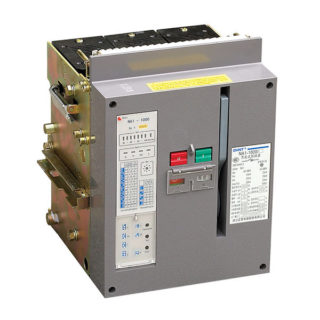
The power cut-off switch is available in 5 climatic categories and is designed to operate under the following conditions:
- installation at an altitude of 1000 m above sea level;
- outside air temperature from -40 to +40 degrees, excluding frost and dew;
- relative air humidity 90% (+20 degrees) and 50% (+40 degrees);
- premises without dust, aggressive concentration of vapors and gases, there is no explosive atmosphere and dust on the street;
- mounting on a surface where water droplets, oils, and radiation particles cannot reach.
The dependence of the operating parameters of the switches on the environmental conditions is spelled out in GOST 17516.1-90.
Classification of devices
Based on the classification of the PUE, users can select devices of one of the categories.
MA
Produced without thermal release. The models are suitable for the network to which powerful units are connected. An overcurrent relay is used as overload protection. The fuse protects the line from overcurrent in the event of a short circuit.
Class A
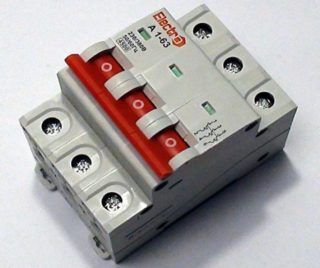
Sensitive modifications with thermal release actuation when the current is increased by 30%. The machines are different:
- a coil that de-energizes the network in 0.05 seconds when normal readings are exceeded;
- bimetallic element - turns off the power after 20-30 seconds.
With the help of devices, the connection of circuits with semiconductors is organized.
Class B
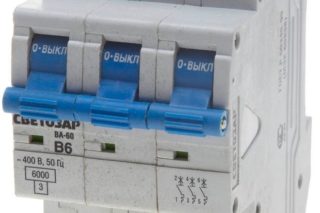
The equipment is suitable if you have a private house or apartment. It is used to connect to socket, lighting lines. Characterized by:
- tripping of the electromagnetic release when the readings increase by 200% in 0.015 sec;
- by triggering the bimetal plate after 4-5 seconds.
The starting current value for such a device should be minimal.
Class C
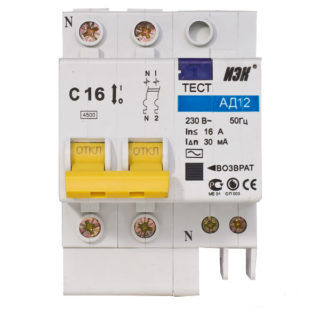
The automatic selective device can be supplied in the household network. The electromagnetic unit is triggered when the rated current is 5 times higher. The thermal release becomes active after 1.5 sec. Class C devices are used at the input.
Class D
They are used to organize a common power line as backup protection. They are triggered when the main equipment cannot de-energize in a timely manner. The electric current rating must exceed the norm 10 times.
Classes K and Z
The response time depends on the type of current in the network with an inductive type of load. The alternating current should be 12 times more than the norm, the constant one - 18 times. The electromagnetic solenoid is activated after 0.02 seconds, the heat unit - when the current increases by 5%.
Characteristics of automatic fuses
The differential device must be selected based on the rated tripping limit, the number of poles, the time-current indicator and the rated operating current.
Rated breaking capacity
- 4.5 kA - used as protection of the power line of a private house. The resistance of the cable is 0.05 Ohm, the current limit is 500 A;
- 6 kA - installed in the residential sector or public buildings with a resistance of 0.04 Ohm and a current limit of 5.5 kA;
- 10 kA - protects industrial installations, since a current of up to 10,000 A occurs in a short line laid from the substation.
For domestic use, 6 kA models are suitable.
Number of poles
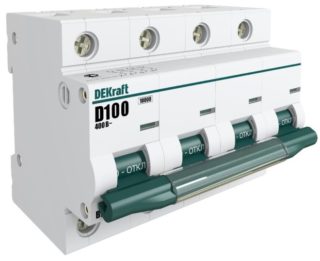
According to this parameter, you can set the number of wires for connection. There are 4 modifications:
- Single pole. It is possible to put the outlet and power cables on the switch, but it will only protect against fire. The neutral is placed on the zero bus bypassing the machine. A phase is interrupted when switched off.
- Bipolar. De-energize all wiring at the same time. They are used when a single-phase device is connected (boiler, water heater). The machine is connected to it with 2 power wires and 2 outlet wires.
- Three-pole. Used when there is a three-phase or four-phase power supply in the network. They are connected in a triangle or star pattern.
- Four-pole. The device required for 6 wires (3 - phase, 3 - protection). Connection for 8 cables is allowed (4 - phase with neutral, 4 - outgoing, i.e. phase and zero).
The quadrupole is used to supply current to industrial equipment.
Time-current indicator
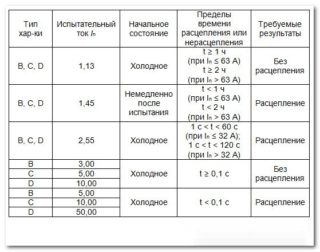
The amount at which an automatic device will turn off the network before reaching a critical point. Triggering occurs:
- for 10 or more ms;
- in 6-10 ms;
- in 2.5-6 ms.
The higher the category, the less the network cable heats up.
Working current rating
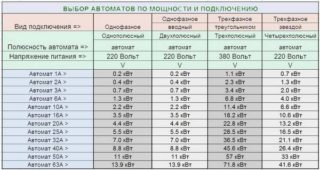
A characteristic that determines the response speed of the device when the current rises above the nominal value. There are modifications on the market:
- 1 and 2A - provide electricity for a small number of devices with a total power not exceeding the capabilities of the device;
- 3A - industrial version with triangular three-phase connection;
- 6A, 10A and 16A - used to power individual rooms and apartments;
- 16A - have 3 or 4 poles, are installed at the input with a three-phase power supply;
- 20A, 25A, 32A - installed to protect apartments with a large number of household appliances;
- 40A, 50A, 63A - high-power devices for industrial and construction lines.
Use modification 25A for the apartment at the input.
An automatic machine for 6, 16, 40 or 20 Amperes is produced in a closed or open case, mounted on a wall, in a special niche or in a combined way. When installed in a control cabinet, it is fixed on a DIN rail. Manufacturers produce models with or without mechanical fasteners.
Features of electronic fuses and current limiters
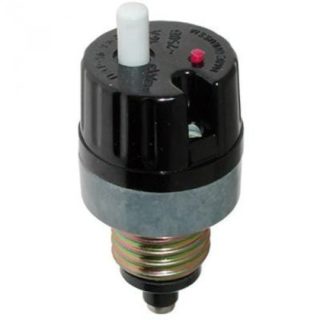
Legacy type fuse gets hot when exposed to current. Some users put a jumper for the machine in the shield. A massive product disrupts the normal operation of the equipment and causes a fire.
For multiple protection, an electronic fuse is used with the following functions:
- self-healing of the circuit after eliminating the source of the breakdown;
- restoration of the network after human intervention.
Devices can notify about faults using sound and light signals.
The second protection option is a current limiter. For this, a single-module constant current generator is used. The size of the limitation is set by the manufacturers. It will not rise even when part of the circuit or the entire line has been short-circuited.
Stabilizers with thyristors and current sensors are switched on when the load increases. The thyristor grooves the circuit so that the output voltage becomes zero.
How many circuit breakers can be used
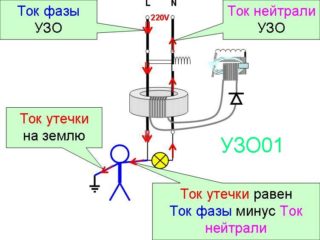
In one electrical panel, a differential current switch of a group network with a value of more than 30 mA must not be installed.PUE does not prohibit the connection of several machines, provided that there is no current leakage. Before starting work, the group leakage should be calculated.
- Measure the actual indicator with a variable resistor.
- Calculate the theoretical value on the basis of clause 7 of the PUE - for 1 A load there are 0.4 mA and 10 μA for 1 m of cable.
To find the right amount of RCDs, you will need:
- When connecting, for example, 3 RCDs of 16 A, add the values each.
- Multiply the resulting value by 0.4 mA.
- Calculate the length of the wire according to the apartment diagram and multiply by 10 μA.
- Add up the values and find out the leak.
Clause 7.1.83 of the PUE reports that the maximum leakage should not exceed the maximum differential current limit of the RCD, which is 10 mA.
How many wires are allowed to be connected to one machine
It is allowed to connect no more than 2-3 conductors with the same cross-section per device. If there is one RCD and two automatic machines in the dashboard, 2 lines are organized. If there is a difference in cable cross-sections, twist is made and clamped.
If there is no possibility of combining the cores to the switchboard, they are twisted in a box and 1-2 cables are fed to the machines. The DIN rail requires modular snap-on terminals to be installed and powered from the switches. This solution provides for additional space in the switch box.
A circuit breaker at the entrance to an apartment or house ensures the safety of the home electrical network. The device timely turns off the power when the specified threshold of parameters is exceeded. This protection prevents accidents, breakdowns of household appliances and injury to the user.

